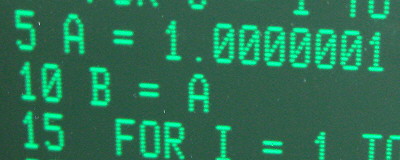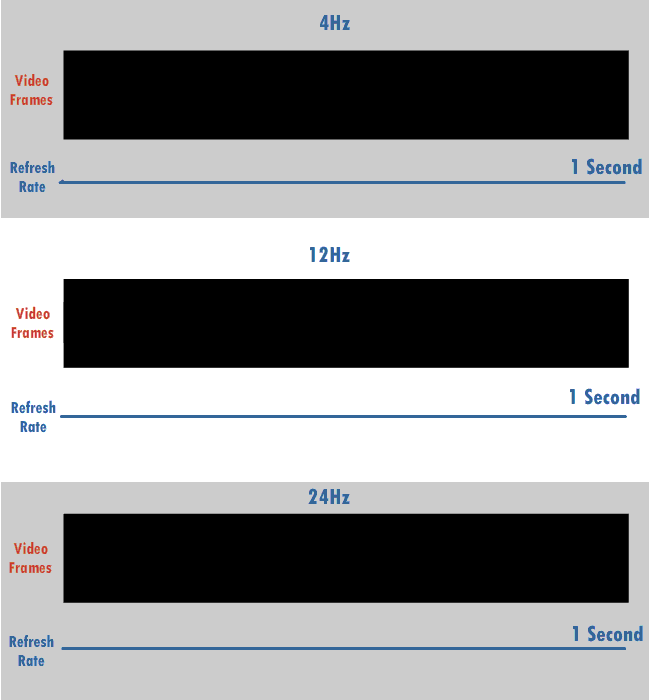|
XFree86 Modeline
: ''A mode line may also refer to a line for the Emacs and Vim (text editor), Vim editors that provides information about the file and modes.'' A modeline is a configuration line in xorg.conf or the XFree86 configuration file (XF86Config) that provides information to the display server about a connected computer monitor or television and how to drive it at a specified display resolution. The Modeline is based on the Generalized Timing Formula or the Coordinated Video Timings standards produced by VESA. Modelines are now rarely used, but XFree86 and the Xorg Server still allow them to be set should the EDID information be inadequate. Syntax Each modeline has ten parameters, beginning with a label for the resolution being specified. The second parameter specifies the rate of the pixel clock in megahertz. Then follow four numbers that together specify the ''x''-resolution (width) and related parameters, and four numbers that specify the ''y''-resolution (height). * Modeline syntax ... [...More Info...] [...Related Items...] OR: [Wikipedia] [Google] [Baidu] |
Emacs
Emacs (), originally named EMACS (an acronym for "Editor Macros"), is a family of text editors that are characterized by their extensibility. The manual for the most widely used variant, GNU Emacs, describes it as "the extensible, customizable, self-documenting, real-time display editor". Development of the first Emacs began in the mid-1970s, and work on GNU Emacs, directly descended from the original, is ongoing; its latest version is , released . Emacs has over 10,000 built-in commands and its user interface allows the user to combine these commands into macro (computer science), macros to automate work. Implementations of Emacs typically feature a dialect (computing), dialect of the Lisp (programming language), Lisp programming language, allowing users and developers to write new commands and applications for the editor. Extensions have been written to, among other things, manage Dired, files, Secure Shell, remote access, Gnus, e-mail, Org-mode, outlines, multimedia, Magit, Git ... [...More Info...] [...Related Items...] OR: [Wikipedia] [Google] [Baidu] |
EDID
Extended Display Identification Data (EDID) and Enhanced EDID (E-EDID) are metadata formats for display devices to describe their capabilities to a video source (e.g., graphics card or set-top box). The data format is defined by a standard published by the Video Electronics Standards Association (VESA). The EDID data structure includes manufacturer name and serial number, product type, phosphor or filter type (as chromaticity data), timings supported by the display, display size, luminance data and (for digital displays only) pixel mapping data. DisplayID is a VESA standard targeted to replace EDID and E-EDID extensions with a uniform format suited for both PC monitor and consumer electronics devices. Background EDID structure (base block) versions range from v1.0 to v1.4; all these define upwards-compatible 128-byte structures. Version 2.0 defined a new 256-byte structure but it has been deprecated and replaced by E-EDID which supports multiple extension blocks. HDMI versio ... [...More Info...] [...Related Items...] OR: [Wikipedia] [Google] [Baidu] |
Raster Scan
A raster scan, or raster scanning, is the rectangular pattern of image capture and reconstruction in television. By analogy, the term is used for raster graphics, the pattern of image storage and transmission used in most computer bitmap image systems. The word ''wiktionary:raster, raster'' comes from the Latin word ''wiktionary:rastrum, rastrum'' (a rake), which is derived from ''wiktionary:radere, radere'' (to scrape); see also rastrum, an instrument for drawing musical staff lines. The pattern left by the lines of a rake, when drawn straight, resembles the parallel lines of a raster: this line-by-line scanning is what creates a raster. It is a systematic process of covering the area progressively, one line at a time. Although often a great deal faster, it is similar in the most general sense to how one's gaze travels when one reads lines of text. In most modern graphics cards the data to be drawn is stored internally in an area of semiconductor memory called the framebuffer. ... [...More Info...] [...Related Items...] OR: [Wikipedia] [Google] [Baidu] |
HDTV
High-definition television (HDTV) describes a television or video system which provides a substantially higher image resolution than the previous generation of technologies. The term has been used since at least 1933; in more recent times, it refers to the generation following standard-definition television (SDTV). It is the standard video format used in most broadcasts: Terrestrial television, terrestrial broadcast television, cable television, satellite television. Formats HDTV may be transmitted in various formats: * 720p (): 921,600 pixels * 1080i () interlaced scan: 1,036,800 pixels (≈1.04Mpx). * 1080p () progressive scan: 2,073,600 pixels (≈2.07Mpx). ** Some countries also use a non-standard CTA resolution, such as : 777,600 pixels (≈0.78Mpx) per field or 1,555,200 pixels (≈1.56Mpx) per frame When transmitted at two megapixels per frame, HDTV provides about five times as many pixels as SD (standard-definition television). The increased resolution provides for a cl ... [...More Info...] [...Related Items...] OR: [Wikipedia] [Google] [Baidu] |
Double Scan
A flicker fixer or scan doubler is a piece of computer hardware that de-interlaces an output video signal. The flicker fixer accomplishes this by adjusting the timing of the natively interlaced video signal to suit the needs of a progressive display for example a CRT computer monitor. Flicker fixers in essence create a progressive frame of video from two interlaced fields of video. Flicker fixers sample the NTSC/PAL output from the output device and store each scan line from the field currently being displayed in RAM while simultaneously outputting the line alternately with the corresponding neighboring lines from the field stored previously (''weaving''). Some more advanced flicker fixers integrated in add-on graphics cards use more sophisticated methods. Outputting the image at double scan rate essentially composes a progressive display with all lines from both fields at full vertical refresh rate. This promotes the horizontal frequency of the signal from 15.734 kHz t ... [...More Info...] [...Related Items...] OR: [Wikipedia] [Google] [Baidu] |
Interlaced Video
Interlaced video (also known as interlaced scan) is a technique for doubling the perceived frame rate of a video display without consuming extra Bandwidth (signal processing), bandwidth. The interlaced signal contains two field (video), fields of a video frame captured consecutively. This enhances motion perception to the viewer, and reduces flicker (screen), flicker by taking advantage of the characteristics of the human visual system. This effectively doubles the time resolution (also called ''temporal resolution'') as compared to non-interlaced footage (for frame rates equal to field rates). Interlaced signals require a display that is natively capable of showing the individual fields in a sequential order. cathode-ray tube, CRT displays and ALiS plasma displays are made for displaying interlaced signals. Interlaced scan refers to one of two common methods for "painting" a video image on an electronic display screen (the other being progressive video, progressive scan) by sc ... [...More Info...] [...Related Items...] OR: [Wikipedia] [Google] [Baidu] |
Hertz
The hertz (symbol: Hz) is the unit of frequency in the International System of Units (SI), often described as being equivalent to one event (or Cycle per second, cycle) per second. The hertz is an SI derived unit whose formal expression in terms of SI base units is 1/s or s−1, meaning that one hertz is one per second or the Inverse second, reciprocal of one second. It is used only in the case of periodic events. It is named after Heinrich Hertz, Heinrich Rudolf Hertz (1857–1894), the first person to provide conclusive proof of the existence of electromagnetic waves. For high frequencies, the unit is commonly expressed in metric prefix, multiples: kilohertz (kHz), megahertz (MHz), gigahertz (GHz), terahertz (THz). Some of the unit's most common uses are in the description of periodic waveforms and musical tones, particularly those used in radio- and audio-related applications. It is also used to describe the clock speeds at which computers and other electronics are driven. T ... [...More Info...] [...Related Items...] OR: [Wikipedia] [Google] [Baidu] |
Refresh Rate
The refresh rate, also known as vertical refresh rate, vertical scan rate or vertical frequency in reference to terminology originating with the cathode-ray tubes (CRTs), is the number of times per second that a raster-based display device displays a new image. This is independent from frame rate, which describes how many images are stored or generated every second by the device driving the display. On CRT displays, higher refresh rates produce less flickering, thereby reducing eye strain. In other technologies such as liquid-crystal displays, the refresh rate affects only how often the image can potentially be updated. Non-raster displays may not have a characteristic refresh rate. Vector displays, for instance, do not trace the entire screen, only the actual lines comprising the displayed image, so refresh speed may differ by the size and complexity of the image data. For computer programs or telemetry, the term is sometimes applied to how frequently a datum is updated with a ... [...More Info...] [...Related Items...] OR: [Wikipedia] [Google] [Baidu] |
Sync Pulse
Analog television is the original television technology that uses analog signals to transmit video and audio. In an analog television broadcast, the brightness, colors and sound are represented by amplitude, phase and frequency of an analog signal. Analog signals vary over a continuous range of possible values which means that electronic noise and interference may be introduced. Thus with analog, a moderately weak signal becomes snowy and subject to interference. In contrast, picture quality from a digital television (DTV) signal remains good until the signal level drops below a threshold where reception is no longer possible or becomes intermittent. Analog television may be wireless (terrestrial television and satellite television) or can be distributed over a cable network as cable television. All broadcast television systems used analog signals before the arrival of DTV. Motivated by the lower bandwidth requirements of compressed digital signals, beginning just after ... [...More Info...] [...Related Items...] OR: [Wikipedia] [Google] [Baidu] |
Megahertz
The hertz (symbol: Hz) is the unit of frequency in the International System of Units (SI), often described as being equivalent to one event (or cycle) per second. The hertz is an SI derived unit whose formal expression in terms of SI base units is 1/s or s−1, meaning that one hertz is one per second or the reciprocal of one second. It is used only in the case of periodic events. It is named after Heinrich Rudolf Hertz (1857–1894), the first person to provide conclusive proof of the existence of electromagnetic waves. For high frequencies, the unit is commonly expressed in multiples: kilohertz (kHz), megahertz (MHz), gigahertz (GHz), terahertz (THz). Some of the unit's most common uses are in the description of periodic waveforms and musical tones, particularly those used in radio- and audio-related applications. It is also used to describe the clock speeds at which computers and other electronics are driven. The units are sometimes also used as a representation o ... [...More Info...] [...Related Items...] OR: [Wikipedia] [Google] [Baidu] |
Pixel Clock
In digital imaging, a pixel (abbreviated px), pel, or picture element is the smallest addressable element in a raster image, or the smallest addressable element in a dot matrix display device. In most digital display devices, pixels are the smallest element that can be manipulated through software. Each pixel is a sample of an original image; more samples typically provide more accurate representations of the original. The intensity of each pixel is variable. In color imaging systems, a color is typically represented by three or four component intensities such as red, green, and blue, or cyan, magenta, yellow, and black. In some contexts (such as descriptions of camera sensors), ''pixel'' refers to a single scalar element of a multi-component representation (called a ''photosite'' in the camera sensor context, although ''sensel'' is sometimes used), while in yet other contexts (like MRI) it may refer to a set of component intensities for a spatial position. Software on ear ... [...More Info...] [...Related Items...] OR: [Wikipedia] [Google] [Baidu] |






